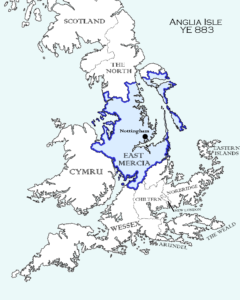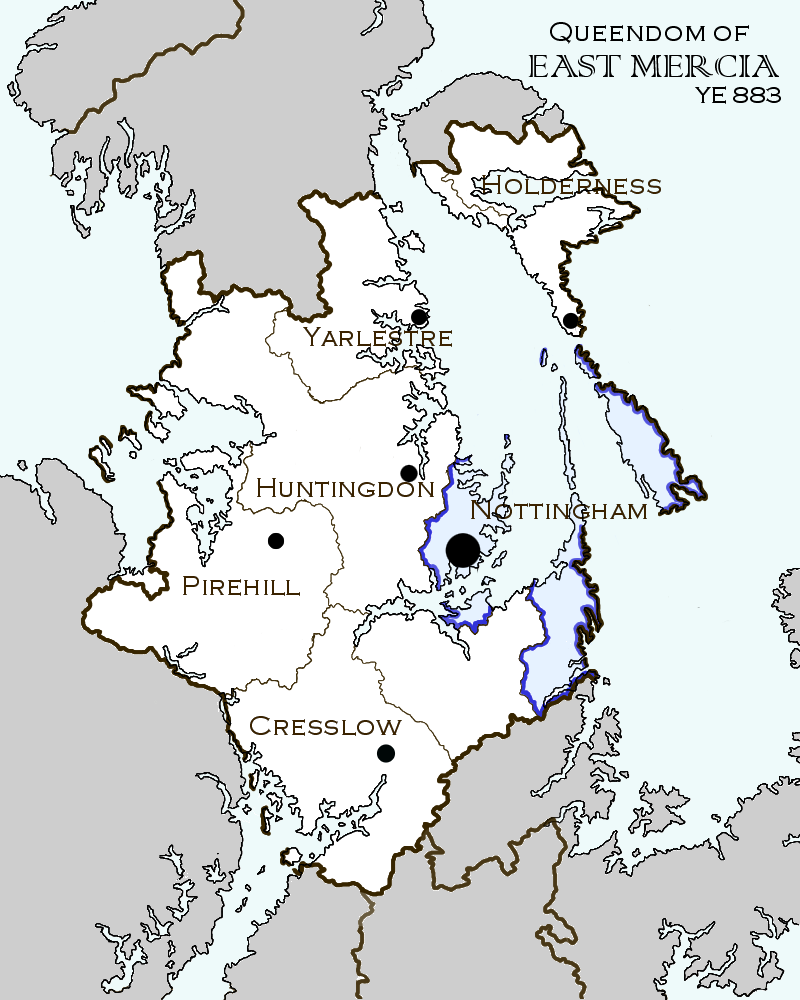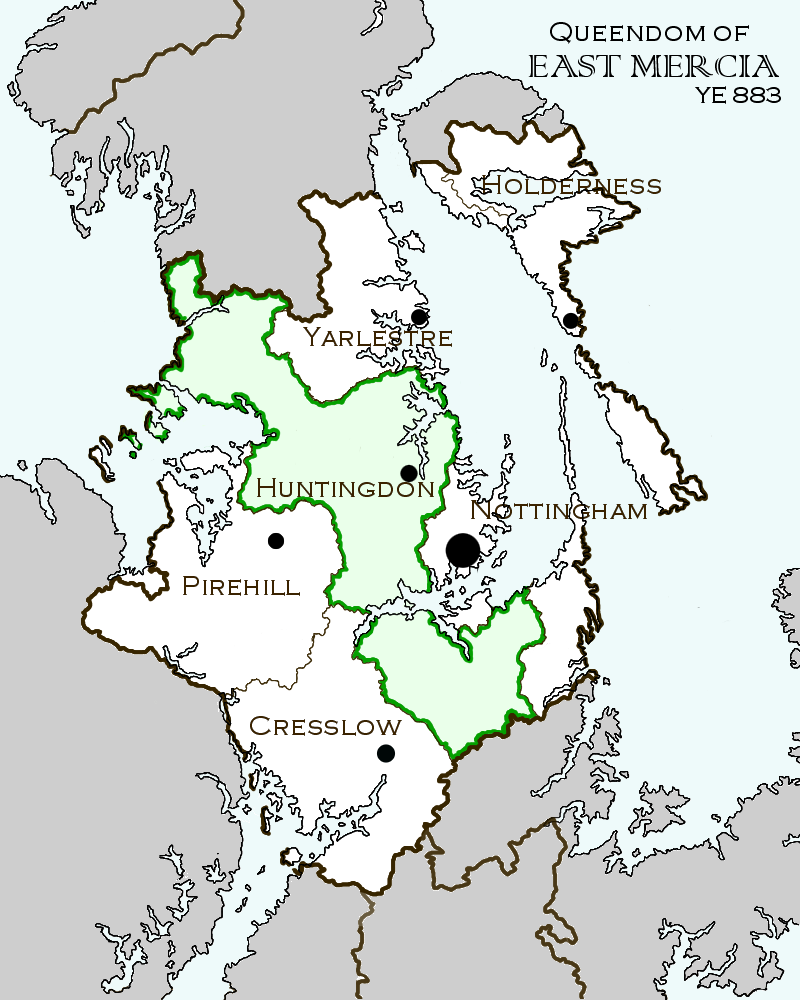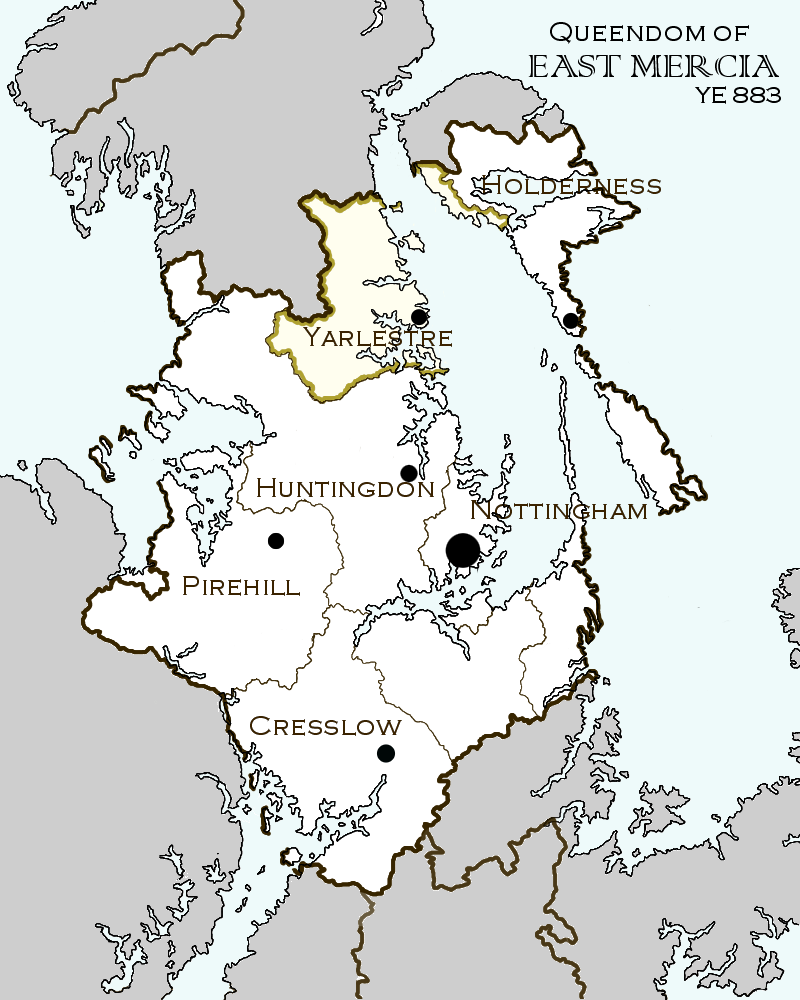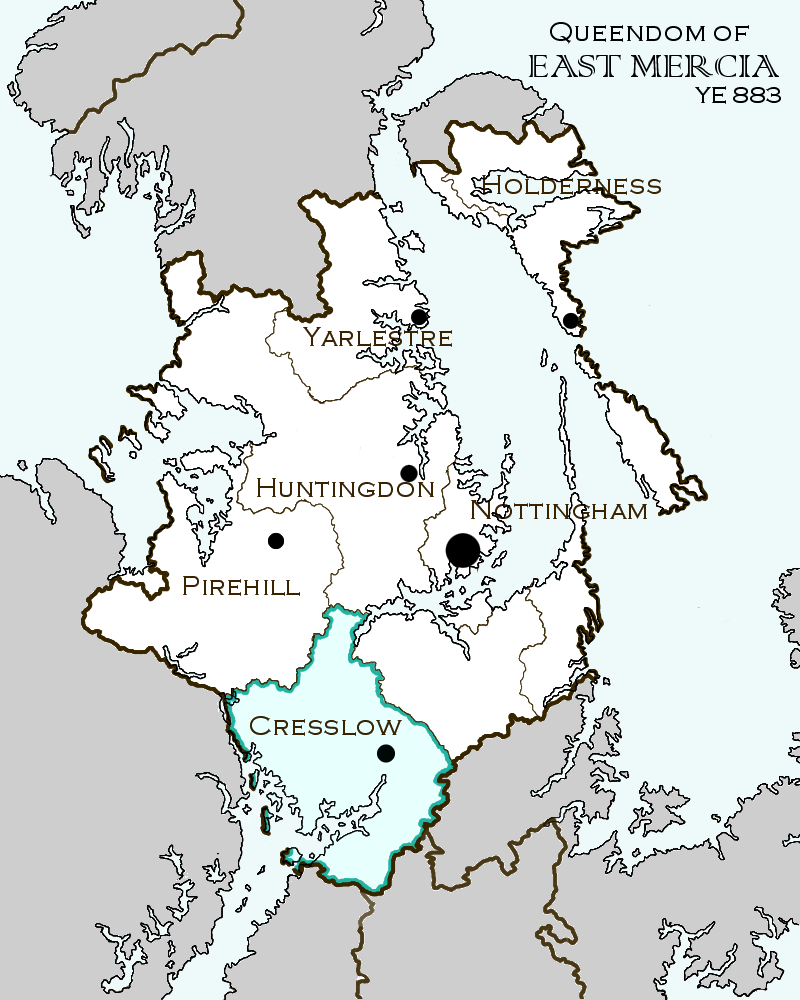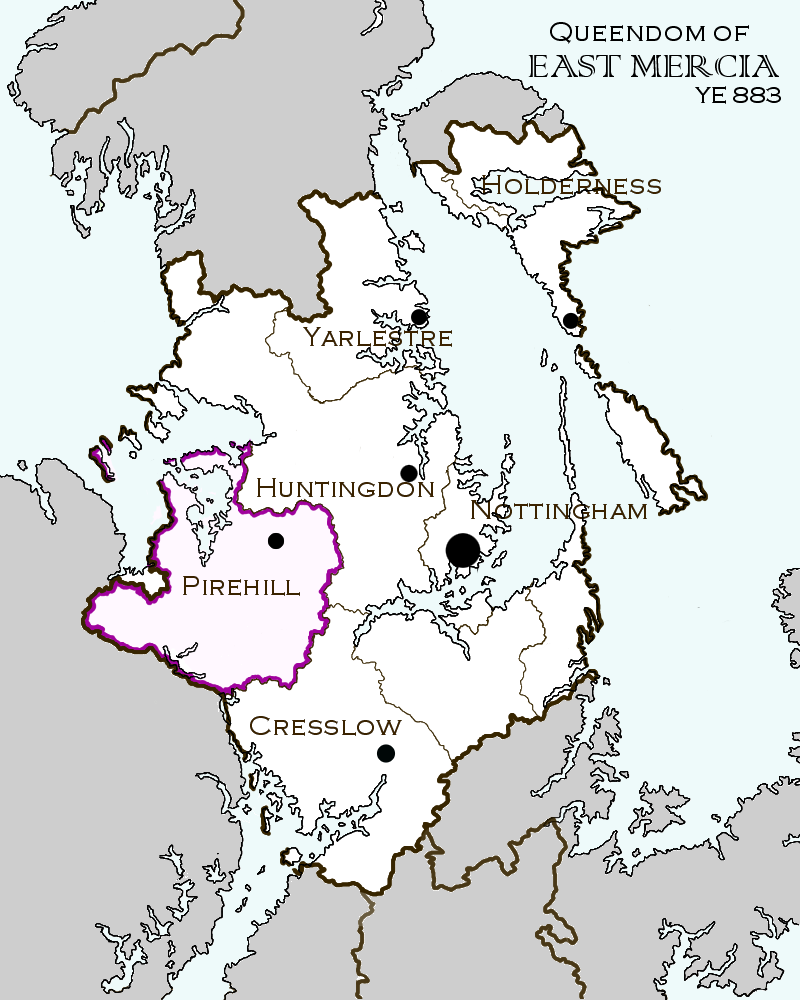Queendom of East Mercia
Jump to
Recommended Pages
The Queendom of East Mercia is a country occupying the center of the Anglia Isle and incorporating the Trent Estuary and several small islands. Its capital city is Nottingham. It borders the Archmarcdom of the North and the Kingdom of Cymru, and is separated from the Queendom of Chiltern by a region of wasteland left from the Great Torrent of YE 781. With a population of 13 million, it is the largest and most populous country of the Isle.
The Queendom is divided into six Marcdoms, each with its own capital city and each presided over by a margrave. Its current monarch is King John II, of the Fitzwalter family, who rules with the support of the Council, made up of the margraves.
Outside the major cities and towns of the Queendom, much of the land is rural, except for some small villages.
History
Origins and Precursors
The Queendom is a successor to the Marcdom of East Mercia, created by Matilda Beauclerc, Empress Matilda of England upon her victory in the First Hycath War in 1141. During the ensuing First Age of Hycath, East Mercia was one of sixteen new Marcdoms supporting the ruling seat of London. Each was under the jurisdiction of a woman, often a Hycatha, who had either seen active service in the five-year conflict or had strong links to it. The first Margrave was Gabriella Fitzwalter, a Cyntha from Nottingham who had served as general of the Empress’s army at the Battle of Lincoln, in which King Stephen of Blois was defeated. In keeping with the matrilineal succession of Hycathic England, the Marcdom would pass to Gabriella’s daughter, Alviva, upon her death in YE 25 (1165 AD). It then continued down the female Fitzwalter line. Nottingham would be their seat and the Marcdom’s most prominent city even then.
Second Age of Hycath (YE 238 – 533)
In the wake of the Sacking of the Vatican in YE 238, England had just lost its Empress, Matilda VI. In order to avoid another war of succession, the country was split into eleven Queendoms, each their own jurisdiction independent of the others and with no centralised rule over the whole landmass, renamed the Anglia Isle. East Mercia became one of these Queendoms, with Nottingham its new capital and Mary-Anne Fitzwalter, who had been forced to kill Matilda VI to curb her lust for absolute power, reigning as its first Queen. Decades later, one of the Founding Families of the new incarnation of East Mercia, the Olivers, attempted a coup. Mary-Anne’s own granddaughter, Queen Cecily, stopped the coup and banished the Olivers from the Queendom.
Acorn Uprising and Age of Equality
The Queendom played a large part in the events leading to the Anglia Isle’s Age of Equality in the late 7th Century YE. The Oliver family, now consolidated in the West of the Anglia Isle with their new city of Fort Oliver, mounted a rebellion. Their intention was to initiate the restoration of England under their centralised rule. They spread through Cymru and arrived in East Mercia by YE 531, where two of the younger Olivers murdered Queen Alviva and her teenage daughter and heir, Gabriella. Thus, the Hycathic royal line of the Queendom was cut short. Jonathan Fitzwalter, brother of the slain Queen, and his partner, Eleanor Loxley, defeated the Olivers at the Battle of Anglia in YE 533.
The Acorn Uprising marked the end of the Second Age of Hycath. East Mercia remained a Queendom, though it gained its first King in Jonathan Fitzwalter, who ruled for another eleven years until his death in YE 544. Eleanor succeeded him as Queen in her own right until their son Richard I ascended the throne in YE 576.
Second Hycath War (ca. YE 740s-750s)
The Hycathae would lose the last vestiges of their political power when they lost the Second Hycath War in the mid-8th century YE. Many left or were banished, heading to the Adrar Plateau in Africa where they founded Al-Murooj, the Promised Land.
The Change (YE 781 – present)
East Mercia was severely affected by the Great Torrent of YE 781, losing 30% of its surface area. Parts of the former coastline survived as a series of small islands, and sea tides rendered much of the land infertile. The agrarian elements of the Queendom suffered heavily as a result, and East Mercia passed through a period known as the Long Famine, which lasted into the second decade of the 9th century YE. The shortages created a hostile climate, and the people of the Queendoms flocked to their major cities for protection, East Mercia being no exception. Villages such as Brackenhurst remain mostly abandoned to this day as a result, with the bulk of the population residing in Nottingham and the other Marcdom’s capital cities.
Conflict with the Promised Land (YE 876-878)
East Mercia’s severe losses from the Great Torrent put it in a position needing to negotiate a deal with Al-Murooj, the Promised Land, whose scientific minds had developed a seed capable of growing on saltwater and under more extreme conditions. With this seed, the Queendom would be able to replenish its meagre food supply. Unfortunately, the negotiations came to nothing and, by YE 876, King Richard IV had secured the public support to take the East Mercian Army to Al-Murooj, installing his niece, Marian Fitzwalter, as regent upon his departure.
Initial attempts to put pressure on the city’s elders were met with their firm resistance, so King Richard was compelled to escalate the conflict into all-out war in YE 877. Back in East Mercia, the lack of clear information and the drain on financial resources caused tension. The growing strain on public morale was being exploited by political agitators such as Will Scarlett. Also, Marian had now abdicated and Richard’s brother, John Fitzwalter, had assumed the position of regent. His solution to the increasing tension was to appeal to the people’s need for security by splitting Nottingham into Inner and Outer Circles, and constructing a Wall to separate them. The plans were supported by the majority, and support only increased with the news, brought by returning survivors, that King Richard and several of his army, including champion archer Robyn Loxley, had been killed or been taken hostage. John, now King of East Mercia, saw the project through to completion by YE 878.
Marcdoms of East Mercia
Nottingham
Nottingham is the central Marcdom of the Queendom, both geographically and politically; it is largely centred on the city of Nottingham, which functions as its Marcdom’s capital as much as the Queendom’s capital. It is the Marcdom of the Fitzwalters, who have their seat at East Mercia Palace, whilst maintaining Nottingham Castle as a private residence. As ruling monarch the Fitzwalters also hold the title of Margrave of Nottingham. The Marcdom lost approximately two-thirds of its land to the Great Torrent and was thus hit hardest of all the Marcdoms in the country, with Nottingham now becoming a coastal city. A few small islands remain from the lost land in the east. The Marcdom expanded twice in it’s history; first in YE 309 when Queen Cecily averted the Oliver Coup and the Oliver lands were divided between the Fitzwalters and the Loxleys; and secondly in YE 469 when the area of Ruthland was annexed to East Mercia and becoming part of the Marcdom.
Huntingdon
The Marcdom of Huntingdon stretches through the middle of the Queendom and is the only Marcdom that borders to all other Marcdoms in the country. It belongs to the Loxley family, who together with the Fitzwalters have been in power since the creation of the Queendom in YE 238 and whose head – currently Robyn Loxley – serves as Warden of the Guard. They maintain the Loxley Estate, on which sits their seat, Huntingdon Hall, located close to the Marcdom’s capital, Loxton. Huntingdon is the biggest Marcdom in the country and has expended its territories three times in history. Firstly, in YE 273 after a dispute with the royal house of the neigbouring Queendom of Ripon turned violent, the Loxleys conquered the South Yorkshire region of Ripon. Secondly, Huntingdon was awarded extra lands in YE 309 when they helped quell the Oliver coup and gained half of the Oliver lands in East Mercia. The last and biggest expansion was in YE 533 after Eleanor Loxley was the key part in bringing the Acorn rebellion to its knees and confiscated the lands previously belonging to the Queendom of Rochdale. Like every Marcdom, Huntingdon was affected by the Great Torrent – with Loxton also becoming a coastal city – but the Marcdom of Huntingdon remains one of the Marcdoms to have best survived the Change.
Yarlestre
The Marcdom of Yarlestre lies at the north of the country and was previously the separate Queendom of Ripon ruled by the House of Clifton. In YE 538 Queen Eleanor invaded and thus began a war over the lands of Ripon that lasted for nearly three decades. In YE 566 a cousin of the reigning Queen of Ripon made a deal with Eleanor; the Clifton family would swear fealty to the crown of East Mercia in exchange for keeping control of their lands as Margraves. Queen Eleanor excepted the deal and Ripon was incorporated in the Queendom of East Mercia and the Marcdom of Yarlestre was created. They reside in York at their family seat – Ripon Palace – and their head – currently Charles Clifton – serves as Warden of the Peace. This Marcdom was hit hard by the Great Torrent, and lost a third of their landmass. To this day the Cliftons remain on strenuous terms with the Loxley family, having lost both lands and their monarch titles to them.
Holderness
Holderness is currently the smallest Marcdom at the northeast corner of the Queendom. Previously, the lands of Holderness was part of the Queendom of Beverly. When the royal House of Barton saw the devastation East Mercia had inflicted on Ripon, they choose a different strategy when East Mercia reached their borders. The young queen brokered a marriage alliance between herself and the crown prince of East Mercia and in YE 568 Beverly joined East Mercia. The Queen relinquished her titles as monarch of Beverly and accepted the new titles of Margrave of Holderness and Warden of the Lands for her sister, knowing that her own offspring would be Kings and Queens of East Mercia. Their head – currently George Barton – resides at Beverly Castle in the capital of Bartonbury. As the other eastern Marcdoms, Holderness lost many acres of its land to the Great Torrent, being reduced to half its original size.
Cresslow
The territories of the south-western Marcdom of Cresslow have changed hands on many occasions of its history. Originally belonging to the royal House of Aldridge of West Mercia, they were chased from their lands by the Cymraeg forces only weeks after the creation of the Queendom of West Mercia in YE 238. Over the centuries that would follow the Aldridges would fight back and occasionally win back their throne, but only for short amounts of times – which would earn them the nickname of the One-Year Royals. In YE 610 they sought an alliance with East Mercia to for once and for all claim back their birthright. They only succeeded partly in their goal as they only managed to conquer half of West Mercia’s original territories and the Aldridges were only given half of the conquered territories to rule over as Margraves – they would never be kings and queens again. The head of the family – currently Deborah Aldridge – serves as Warden of the Treasury and resides at their family seat of Cresslow Park in Coventry. Their Marcdom survived the Great Torrent relatively well, with only losing some lands when the River Severn expanded past its borders.
Pirehill
Located in the west of the Queendom, Pirehill is the Marcdom of the Tuck family, whose head – currently Carol Tuck – serves as Warden of the People. The Tucks are the only family of the six First Families that doesn’t trace their lineage back to a royal house. They were gifted the other half of the West Mercian territories after it was retaken from Cymru as a reward for their loyalty to the East Mercian crown – although others claim that it was so the Princess of Nottingham could marry a Tuck without the scrutiny of marrying someone without a title. As Margraves of Pirehill they reside at Pirehill Heights in the Marcdom’s capital of Tuckenham. During the Great Torrent, they lost quite some lands in the Chester terrain of their Marcdom when the rivers Dee and Mersey found each other. The Tucks proved to be resilient and turned the catastrophe into profitable business and they now own the biggest seafarm of the country.

